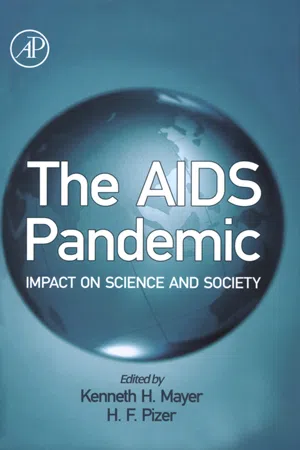
- 520 pages
- English
- ePUB (mobile friendly)
- Available on iOS & Android
About this book
The AIDS Pandemic explores the ways in which HIV/AIDS has, and continues to transform the wide range of related disciplines it touches. Novel perspectives are provided by a unique panel of internationally recognised experts who cover the unprecedented impact onf AIDS on culture, demographics and politics around the world, including how it affected the worlds' economy, health sciences, epidemiology and public health. This important far- reaching analysis uses the lessons learned from a wide array of disciplines to help us understand the current status and evolution of the pandemic, as it continues to evolve.* Unique and timely presentation of new theories and perspectives* Concentrates on the changes that have taken place in a broad array of related disciplines* Provides key contextual information, for those new to the field or at interface areas between disciplines* Includes an international focus on evolving African and Asian experiences* Focuses on the current strategies for developing vaccines and microbicides* Outlines harm reduction and prevention programs* Explores issues related to delivery of life-saving AIDS medications in resource-constrained environments
Frequently asked questions
- Essential is ideal for learners and professionals who enjoy exploring a wide range of subjects. Access the Essential Library with 800,000+ trusted titles and best-sellers across business, personal growth, and the humanities. Includes unlimited reading time and Standard Read Aloud voice.
- Complete: Perfect for advanced learners and researchers needing full, unrestricted access. Unlock 1.4M+ books across hundreds of subjects, including academic and specialized titles. The Complete Plan also includes advanced features like Premium Read Aloud and Research Assistant.
Please note we cannot support devices running on iOS 13 and Android 7 or earlier. Learn more about using the app.
Information
Virology
1 Phyllis J Kanki, DVM, ScD is Professor of Immunology and Infectious Disease at the Harvard School of Public Health. She received her DVM degree from the University of Minnesota and D.Sc. degree in virology from the Harvard School of Public Health. She has directed the collaborative AIDS research program between scientists at Harvard and University Cheikh Anta Diop in Dakar, Senegal for over 18 years, leading a prospective study of commercial sex workers in one of the longest studied cohorts of HIV infected women worldwide. In 2000 she initiated the AIDS Prevention Initiative in Nigeria, a multi-site collaborative and evidence based prevention program, and directs the Rapid Expansion of anti-HIV Treatment in Botswana, Nigeria and Tanzania. She has published widely and received numerous awards worldwide. Her research interests include HIV pathogenesis, molecular epidemiology, and intervention studies. Her work has described major biological differences and interactions between HIV-1 and HIV-2.
2 Myron E Essex, PhD is Chairman of the Harvard AIDS Institute, the Mary Woodard Lasker Professor of Health Sciences at Harvard University and Chairman of the Department of Immunology and Infectious Diseases at the Harvard School of Public Health. He holds doctorates in veterinary medicine and microbiology. He has received numerous awards, including in 1986 the Albert Lasker Medical Research Award (with Drs. Gallo and Montagnier) the highest medical research award given in the United States. Dr. Essex has authored or co-authored more than 450 scientific articles and edited seven books. He was one of the first to link animal and human retroviruses to immunosuppressive disease, suspect that a retrovirus was the agent cause in AIDS, and determine that HIV could be transmitted through blood and blood products. Since 1985, Dr. Essex and colleagues have worked with collaborators in Africa and Asia, where they conduct biological, clinical, and epidemiological studies.
History of the Discovery of HIV
Table of contents
- Cover image
- Title page
- Table of Contents
- Copyright
- Contributors
- Preface
- About the Editors
- Dedications
- Introduction
- 1: Virology
- 2: Immunology in the Era of HIV/AIDS
- 3: Quantitative Science
- 4: The Public Health Response to HIV/AIDS: What Have We Learned?
- 5: AIDS and Sexually Transmitted Disease Prevention and Control
- 6: HIV Treatment Meets Prevention: Antiretroviral Therapy as Prophylaxis
- 7: Challenges in Developing HIV Vaccines
- 8: Microbicides
- 9: AIDS Behavioral Prevention: Unprecedented Progress and Emerging Challenges
- 10: The Evolution of Comprehensive AIDS Clinical Care
- 11: The Ever-changing Face of AIDS: Implications for Patient Care
- 12: Economics
- 13: Expanding Global Access to ARVs: The Challenges of Prices and Patents
- 14: The African Experience
- 15: Asia: Health Meets Human Rights
- 16: How HIV/AIDS Changed Gay Life in America – And What Others Can Learn from Our Experience
- 17: Drug Use
- 18: Management of HIV/AIDS in Correctional Settings
- 19: Medical Ethics and the Law
- Index